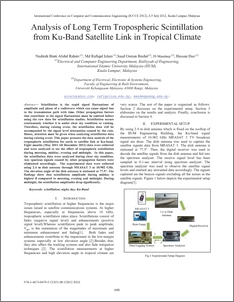Abdul Rahim, Nadirah Binti and Islam, Md. Rafiqul and Bashir, Saad Osman and Mandeep , J. S. and Dao, Hassan
(2012)
Analysis of long term tropospheric scintillation from Ku-band satellite link in tropical climate.
In: International Conference on Computer and Communication Engineering (ICCCE 2012), 3-5 July 2012, Seri Pacific Hotel Kuala Lumpur.
![[img]](http://irep.iium.edu.my/style/images/fileicons/application_pdf.png)  Preview |
|
PDF (Analysis of Long Term Tropospheric Scintillation from Ku-Band Satellite Link in Tropical Climate )
- Published Version
Download (208kB)
| Preview
|
Abstract
Scintillation is the rapid signal fluctuations of
amplitude and phase of a radiowave which can cause signal lossin the transmission path with time. Other propagation factors that contribute to the signal fluctuations must be omitted before using the raw data for scintillation studies. Scintillation occurs continuously whether it is under clear sky condition or raining. Therefore, during raining event, the scintillation data will be
accompanied by the signal level attenuation caused by the rain. Hence, attention must be given when analyzing scintillation data during raining event. This paper presents the data analysis of the tropospheric scintillation for earth to satellite link at Ku-band.
Eight months (May 2011 till December 2011) data were collected and were analyzed to see the effect of tropospheric scintillation during morning, midday, evening and midnight. In this paper, the scintillation data were analyzed during clear sky condition. Any spurious signals caused by other propagation factors were eliminated accordingly. The experimental data were collected
using 2.4 m dish antenna through MEASAT 3 at 10.982 GHz.
The elevation angle of the dish antenna is stationed at 77.5°. The findings show that scintillation amplitude during midday is highest if compared to morning, evening and midnight. During midnight, the scintillation amplitudes drop significantly.
Actions (login required)
 |
View Item |


 Download Statistics
Download Statistics Download Statistics
Download Statistics